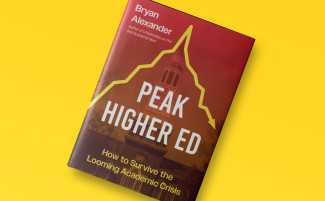
Johns Hopkins UniversityEst. 1876
America’s First Research University
Becoming a Scholar: The Story Behind Becoming T. S. Eliot

By Jayme Stayer
In the prettified TED talks that make achievements accessible to a wide audience, the casually-but-impeccably dressed presenter explains the “wow” moment that jump-started their project. In the narrative that follows—if the presenters are scholars or researchers—they will trace a clearly defined arc in which they followed up on their counter-intuitive hunches, battled their inner demons, thumbed their nose at skeptics, and finally produced the magical, paradigm-busting whatsit (invention, book, procedure) that now re-orients the field.
Cool story, as they say. The problem is that some scholarly achievements begin in the rag and bone shop of the heart, with no clear sense of how they started or where they are headed. My own work on Becoming T. S. Eliot (2021) began in ignorance, uncertainty, and bravado. Many years ago, I had taken pages of notes on Eliot’s early poetry, but I had no idea how such jottings might be shaped into a book-length argument. Although I had never written a book, I certainly wasn’t incompetent: I had a Ph.D. and had published a few modest articles. But while I had a strong writing voice, I had no discernible research agenda, no sense of how my various intellectual interests added up to anything worth publishing. (Hey TED Talk showrunners: I’m ready for my close-up.)
Further complicating my non-existent research agenda was the fact that I had quit academia in 2003, ditching a tenure-track job and a mortgaged house to join the Jesuit priesthood. By 2007, my writing had been on hold for several years. I was halfway through my Jesuit formation, and my superiors asked me to return to university teaching after ordination. This meant heading back into the anxious mindset of Summoning Something to Publish. Fortunately, I had colleagues who offered good advice. David Chinitz—a friend from the International T. S. Eliot Society—was soliciting contributions to A Companion to T. S. Eliot, each chapter of which would deal with some aspect or period of Eliot’s life and work. Sometime before this, when I had asked him what I might write about, David had suggested that the scholarly world needed a monograph on Inventions of the March Hare, Eliot’s juvenile notebook. Some work had been done on the notebook, but it was mostly thematic. What remained to be done was to explain, in a stepwise, chronological manner, how Eliot came to create his remarkable poetic voice between the covers of his notebook.
I could do that, I thought, couldn’t I? Writing a chapter on Eliot’s notebook for the Companion would feel like a dry run: if I could come up with a chapter-length argument about the notebook, maybe I would be able to extend it to a book-length project. Writing that chapter turned out to be pretty easy, taking me only a couple of weeks to draft. And so when I completed it, I forged ahead with plans to extend and deepen the argument. What I didn’t realize was that sketching some ideas in a short article would be radically different from proving those ideas in detail, in a scholarly argument that had not one clear trajectory (as my short chapter seemed to suggest) but multiple trajectories, and whose evidentiary argument would come to rely on archival research. Fortunately for me, I didn’t have a clue about the depths of my cluelessness; otherwise, I might have abandoned the project.
Another unplanned aspect of my project was that I decided to start visiting archives. T. S. Eliot is not exactly a marginal figure, and the archives that hold his manuscripts and related materials have been picked over by thousands of scholars. Since I did not expect to find anything, it’s unclear what motivated me to start going. Perhaps it was because many of my colleagues in the Eliot Society were archival scholars, and it seemed like something I should be doing if I were a serious critic, even though I had zero training in archival work. During the years that I was writing the book, I was able to visit a dozen archives, where I found to my pleasant surprise that there were all kinds of overlooked, relevant details awaiting my plucking.
Several trips to the Berg Collection at the New York Public Library started under the same shaky premises: I was writing on the Inventions notebook, which had been published in a fine scholarly edition in 1995. So I had no idea why I was bothering to look at the original manuscript in the Berg. But here too, the archive spoke to me. I found some minor errors in the scholarly edition, teaching me perhaps my most important early lesson: that you can never trust an edition to be 100% accurate or that an edition’s transcriptions are free of mediating judgments. The messy, evolving handwriting of the notebook also revealed insights to me which a legible scholarly edition elides.
Even as I was working on Becoming T. S. Eliot, I was publishing related articles on what I was finding in the archives, and this attention to detail and mastery of context brought me to the attention of Ronald Schuchard, the General Editor of The Complete Prose of T. S. Eliot, who asked me to co-edit Volume 5 of that series. Here was yet another project begun in ignorance, uncertainty, and bravado. I was not trained as an editor and knew little of Eliot’s prose written between 1934 and 1939, the years of the volume assigned to me. Fast-forward through a clumsy apprenticeship and steep learning curve: the Modern Language Association awarded the volume its Prize for a Scholarly Edition in 2020.

Becoming T. S. Eliot was begun fourteen years ago as my first book, but three other books and several articles got in the way—the consequence of becoming a scholar and having lots to say—and so it turned out to be my fourth book. That I now think of myself as a senior scholar, with useful and important things to say to my fellow scholars comes as something of a surprise to me. It all came about not as a linear narrative that reveals my own solitary talent, but as a weird combination of unplanned turns, strokes of luck, Sitzfleisch, and curiosity, all situated within a collaborative world of peers who encouraged, corrected, advised, and prodded me. During the long course of the book’s drafting—a project exploring how Eliot found his voice as a poet—I found my own voice as a scholar. The lengthy acknowledgments section of my book records the many relationships and help that was offered along the way. I hope these friends and colleagues all see themselves as my collaborators.


